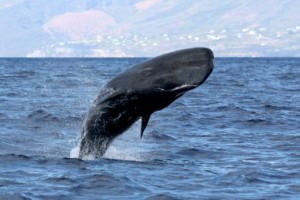Marine Mammal overboard
After helping everybody get back into the zodiac boats from our day outing ashore at Raoul Island, I had a tumble off the side of the boat and ended up in the tide! The water was a subtropical warm, but I was still thankful for a quick and efficient rescue. That was yesterday evening – this morning we prepared for our first official opportunity to go snorkelling.
The early birders got away to Raoul for a walk to Denham Bay. They had to wait their turn in the queue of small craft heading ashore. HMSNZ Wellington had appeared nearby at first light and was ferrying supplies to the island. They also brought new DOC staff for the changeover, as half of the hardy souls who have done their time on Raoul Island were due to depart. Two geologists also went ashore to explore the crater lakes of Raoul and the reported increase in volcanic activity.
The rest of us had our snorkel briefing and were off to the sheltered waters in the lea of the Meyer Islands. Spectacular numbers of fish and a wide range of species met us on entering the water. There are species that people who have snorkelled in the tropics would be familiar with, mixed in with species that are found in the temperate seas around mainland New Zealand: lion fish, yellow tailed king fish, two spot demoiselles, large schools of blue maomao, bluefish and grey drummers.
One type of fish had been on everybody’s mind when we set out….sharks.
The Kermadecs is home to perhaps the only unfished population of Galapagos sharks in the world. We were not disappointed – a few of these sleek animals approached us and passed among the snorkelers. Sharks have a certain elegance compared to the darting movements of the smaller fish.
It’s a very different environment to snorkelling around the New Zealand mainland. There are no large seaweeds but many corals and more tropical species of sea urchin and starfish.
The Islands are home to numerous species of seabirds. Looking up from the water, birds were constantly circling and swooping above this rugged volcanic landscape and the surrounding seas. We saw red-tailed tropic birds (with their long red trailing tail feathers), frigate birds, brown noddies, sooty terns and the occasional masked booby soaring by.
The weather has been very kind to us. We’ve had very calm weather and little or no swell, which made snorkelling easy today. This does not seem to make it easy for some of the petrels, however, which once landed on the water find it a little taxing to take off. I gave one such bird a hell of a fright as I surfaced right next to it, my closest wildlife encounter to date!
After a zodiac trip to the Meyer islands this afternoon, we headed up to Napier Island, the most northerly island of New Zealand. Earlier in the day another group had spotted a rare bird for these latitudes. Twitchers of the world may look at me with disdain but bird names are a foreign language to me. Apparently a red footed booby was seen, but if they told me they had seen a fleet-footed orange gobbler I would probably have accepted that without judgement! Still they were happy and will have ticked off another bird on their list. It may even be a new record for New Zealand, with the closest population in Tonga.
A second run in the evening out to these smaller islands revealed a spectacle of extraordinary proportions as we witnessed seabirds returning in their thousands to roost. Even in the daytime I had been stunned by the numbers of seabirds around the islands. At dusk the skies contained threefold the number of birds swooping noisily and cavorting around the cliffs. Remarkably the red-footed booby was again spotted, in a tree at the very top of Napier Island. The elation of the avid bird watchers was infectious and rounded off a perfect day.

